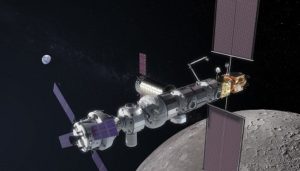NASA's Lunar Gateway and a return to the Moon are the big winners in the 2020 budget proposed for the agency; the futures of planetary and Earth science are less clear.

NASA
Rocket science is easy. It's finding the funding for it that's hard.
The Presidential Budget Request for NASA for the fiscal year 2020 is $21.019 billion — higher than the FY2018 budget, and much higher than the lean years earlier this decade. At the same time, it also represents a 2.2% drop, nearly half a billion dollars, from the just-approved 2019 budget.
Responding to the proposed budget, NASA administrator Jim Bridenstine highlighted NASA's initiative to return to the Moon in the next decade, and then on to Mars in the 2030s. “We will go to the Moon in the next decade in a way we have never gone before,” Bridenstine said in a press release. “This time, when we go to the Moon, we will stay.”
But the 2020 budget would decrease funding for other aspects of the agency, including science and outreach.
What's Inside FY2020
Like other government agencies, NASA has undergone cuts under the Trump administration relative to the general congressional baseline. But there are some big winners, the biggest of which is the proposed Lunar Gateway; it would receive nearly double its funding to put a crewed space station in orbit around the Moon by the late 2020s.
The details of how the agency will carry out construction and operation of the Lunar Gateway isn't immediately clear, though. It may rely on NASA's new Space Launch System (SLS) rocket, which is due to carry out its inaugural flight in 2020, but Bridenstine also just floated the idea of using commercial vehicles. SpaceX just completed the first test flight of its Crewed Dragon spacecraft to the International Space Station, and the company expects to start flying crew to the station this year. Either way, the SLS or commercial rockets would eventually be carrying crew to the Lunar Gateway in the Orion capsule.

NASA
The budget proposal also mentions initiating a Mars Sample Return mission, which would follow up on the Mars 2020 rover. The budget also puts the launch of Europa Clipper in 2023, using a commercial carrier such as the SpaceX Falcon Heavy rocket.
However, even as funding increases for exploration, science is taking a hit, including drops in funding for astrophysics (-20%), planetary science (-4.9%), and Earth science (-7.8%). The beleaguered Wide-Field Infrared Space Telescope (WFIRST), built around a surplus 2.4-meter mirror donated by the National Reconnaissance Office, would also get zeroed out under the 2020 budget. Likewise, the budget proposes zero funding for NASA's Office of STEM Engagement. Only the James Webb Space Telescope — now launching no earlier than March 2021 — is a winner, with a $46.6 million increase in funding in 2020 under the proposed budget.
Proposed vs. Approved
Of course, the latest proposal is just that: a proposal. Enacted budgets nearly always look different from what's proposed early on. For a very recent example, the FY2019 budget request called for $19.9 billion for NASA — a move that likewise would have cancelled WFIRST, STEM outreach, and several Earth science missions. But the budget Congress pushed through upped the amount to $21.5 billion, undoing many of the called-for cuts. The question is, will Congress step in again?
The higher budget NASA is currently enjoying is nevertheless a far cry from its peak in the late 1960s, when it received more than 4% of the overall U.S. budget. There's also the “no Buck Rogers, no bucks” tension between the more expensive crewed space program and the cheaper robotic missions. Many fear the Lunar Gateway project, like the International Space Station, SLS, and James Webb, will become a budgetary black hole.
As always, it's a tug of war between what we'd like to do, versus what we can afford. To quote rocket pioneer Wernher von Braun: “Our two greatest problems are gravity and paperwork. We can lick gravity, but sometimes the paperwork is overwhelming.” NASA missions will have to continue to navigate the congressional labyrinth from proposal to launch.
 3
3









Comments
RMP
March 15, 2019 at 1:26 pm
NASA has also already eliminated funding for the post-Cassini Mission analysis of science data from Cassini, leaving many Cassini scientists with having to scratch up their own funds to analyze and publish over a decade of science data from Saturn. Funds went to the engineering delays of the James Webb.
You must be logged in to post a comment.
Jim-Baughman
March 17, 2019 at 2:31 am
This whole moon project is nothing but trillion dollar flag waving. About as much science will come from it as comes from the ISS--i.e. zero. There are real space science projects crying out (literally) for funding, not to mention billions in cuts to the National Science Foundation, but we're going to the moon again.
You must be logged in to post a comment.
RMP
March 17, 2019 at 12:04 pm
Whether or not that is true, the whole problem is because the NASA funding pie is too small and shrinking for the number of projects that both scientists and politicians want to pursue. Trump's re-hashed 'plan' to return to the Moon -and then go to Mars has the same problem when the Bush II administration pushed the Constellation program - level funding with no increases, while still flying the Shuttles and building the ISS - But going back to the Moon requires many new expensive 'components' that need to built from the ground-up. If the pie is the same size, its just not gonna happen, like feeding 5000 with a couple loaves of bread and some fish. Instead, NASA has to rob Peter to pay Paul...
You must be logged in to post a comment.
You must be logged in to post a comment.